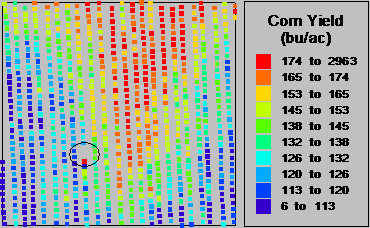

To send a message to an author, click on the author's name at the end of the article.
This Month in Ag Connection | Ag Connection - Other Issues Online
1.Get the recordkeeping for your business up to date.

2.After getting your records current, make two lists to use with your year-to-date profit and loss report:
3. Analyze any non-recurring or abnormally large anticipated receipts or expenditures for next year. For example, are you planning to carry over an unusually large quantity of grain or livestock? Or are you planning to incur any unusually large expenditures for conservation practices, fencing, lime, business expansion, etc.
4. Meet with your tax return preparer prior to the end of the year to make sure everyone is "on the same page" to avoid costly surprises and to insure sufficient time is available to evaluate alternative strategies.
5. Review Social Security management strategies for yourself and your spouse. Do both you and your spouse have sufficient quarters of earnings during the last ten years to qualify for disability benefits?
6. The annual gift exclusion ($13,000 per donee) continues to be one of the most effective and efficient estate planning tools. Be sure to complete all desired 2009 gift transfers prior to the end of the year.
7. The 2009 federal estate exemption is $3,500,000. Conduct an "estate fire-drill" – you just "DIED". Don't worry about the exactness of the estate tax liability, but do you have a taxable estate? How would your assets be distributed? How will your liabilities be handled? Who will manage the business? Do you foresee any intra-family problems? Conducting this "fire-drill" will help you identify your estate and business planning objectives and concerns that may need to be given greater attention.
8. Review and make sure your income, risk, business, retirement, and estate management goals and objectives are all being addressed in a coordinated fashion.
9. Especially during this period of legislative uncertainty regarding the future of estate tax – utilize the most cost efficient and flexible planning tools available that will accomplish your identified goals and objectives.
10.Get Started on Items 1 through 9 Today!
Source: Parman R. Green, MU Extension Ag Business Mgmt. Specialist
This Month in Ag Connection | Ag Connection - Other Issues Online
Yield monitors and the ability to map yields have developed significantly in the last decade, and have played a large part in the development and adoption of precision farming. While farmers have always known that fields are variable, the yield map provides the abilities to quantify and "remember" those variations. Over time with good record-keeping, these maps can provide a roadmap for directed scouting, analysis and possibly treatment of under-performing areas. They also provide a means to evaluate successes (and failures) in management decisions and practices.
However, yield maps are only as good as the data collection and processing techniques used to create them. And while yield monitoring systems and software have become more user-friendly over the last decade, collection and processing of sensor data are by no means completely automated. It is generally understood that proper installation, calibration and testing of the yield monitoring system are crucial in the data collection process. Yet, most people do not realize the necessity of cleaning the processed yield data in preparation for mapping and/or any further analysis.
Why do we need to clean yield data?
The figure helps demonstrate why we should clean yield data. This 330 foot square (approximately 2.5 acres) of corn yield data was clipped from the within a 160 acre field.
There appears to be good yield variation here, and the yield estimates in adjacent transects (which were harvested in opposite directions) seem quite reasonable, indicating that the yield processing was done correctly.
There are really no significant problems with this yield map, except one. Notice the circled area in the lower left portion of the map. It appears from the gap in spacing of the yield points in this region that the combine had to stop for some reason. When this occurred, one point with a high yield was recorded. What really happened here is that the combine stopped rather abruptly, while grain flow to the sensor tailed off slowly over a period of time. A reasonably low grain flow was recorded at this point (1.27 lb/s) but the combine moved a distance of only 0.4 inches during this interval. Performing the yield calculation, a yield estimate of 2963 bu/ac was received for this point. Visually, the effect of this single point is minor. However, calculating an average yield for this 2.5 acre region, including this point gives a value of 143.9 bu/ac. Without this single point, a value of 140.6 bu/ac is obtained, for a difference of 3.3 bu/ac. Imagine the possible effects should several dozen such points exist in a yield map!
The above describes a very common yield map error caused by a rapid velocity changes. Other common errors found in yield maps include the following:

How necessary is it to find and remove errors in yield data? That depends on how the yield data is to be used. If a yield map is to be used solely as a visual tool to assist an individual in recognizing areas of a field that need attention, then very little yield cleaning may be necessary.
Should the user be interested in numerical calculations, such as field or regional yield averages, then more attention to detail is required. Should the user be interested in on-farm research, comparing data layers of yield to other data layers (i.e. aerial imagery, soil nutrients, elevation, slope, etc.), then the greatest of care should be taken to remove all data that might lead to erroneous conclusions.
How do I clean the yield data?
Many of the errors mentioned can be addressed inside the yield processing software provided by yield monitoring system manufacturers. For example, combine delay time, and additional delays for entering and leaving the crop can be set by the yield processing software before the yield data is calculated. However, the process for determining the optimal values for the various settings generally requires visual comparison of several different maps. This can require a significant amount of time and effort if the resulting maps cannot be quickly updated and accurately displayed inside the software.
A simpler alternative for yield processing and cleaning is Yield Editor software developed by USDA-ARS, Cropping Systems and Water Quality Research Unit. Yield Editor accepts data exported from common commercial yield monitoring software systems, and allows a variety of data filters to be set. The yield data is then processed using those settings, the yield map is updated, and the user is able to see what points have been removed by each filter. Most importantly, it allows the user to visually interact with the map, selecting points, transects or whole areas of data to edit, remove or export.
Yield Editor software can be downloaded free of charge at: http://www.ars.usda.gov/Services/Services.htm?modecode=36-22-15-00
For further questions, please contact Kent Shannon, Natural Resource Engineer, email: shannond@missour.edu
This Month in Ag Connection | Ag Connection - Other Issues Online

The best solution is to buy clean grain for swine and dairy as they are most susceptible. Thus, some moldy feed may be fed to beef cattle. Feeder cattle should be able to safely consume levels five to 10 times higher than swine and dairy. Thus, ruminants older than 4 months can withstand 10 to 20 ppm of vomitoxin. Signs of toxicity with vomitoxin/deoxynivalenol (DON) are usually feed refusal or feed intake reduction. At concentrations of 5 to 10 ppm vomitoxin vomiting is observed in swine.
Zearalenone concentrations should not exceed 2 ppm in growing and finishing pigs. Signs of toxicity that may be observed in swine with zearalenone are a disrupted estrus cycle, enlarged mammary glands, and swollen vulva.
If contaminated corn must be fed, the following table lists FDA advisory levels for vomitoxin/deoxynivalenol (DON) in animal feed.
| Species | Vomitoxin (DON), ppm | Not to exceed % of ration |
|---|---|---|
| Swine | 5 | 20 |
| Grow/Finish | 1 | 20 |
| Breeding | 1 | 20 |
| Ruminants | 10 | 50 |
| Chickens | 10 | 50 |
| All Other | 5 | 40 |
Corrective steps:
Calculate the maximum inclusion level of moldy corn:
Need mycotoxin analysis:
Send a sample to the University of Missouri Veterinary Medical Diagnostic Laboratory
Address:
Veterinary Medical Diagnostic Laboratory
Attn: Toxicology
1600 East Rollins Street
Columbia, MO 65211
Phone 573-882-6811
If a grain handler has questions call: Missouri Department of Agriculture, Plant Industries Division, Bureau of Feed and Seed at 573-751-4310
This Month in Ag Connection | Ag Connection - Other Issues Online
We would like to introduce Clint Stith. Clint is the new part-time MU Extension associate livestock specialist in the Central Missouri Region. He is assisting Mark Stewart while he has a special assignment. Clint is originally from Polo, Missouri (Northwest corner of Missouri) and received a B.S. in Animal Science from the University of Missouri-Columbia. His office is located at the MU Extension office in Fulton.
This Month in Ag Connection | Ag Connection - Other Issues Online
With harvest upon use, now is the time to be aware of safe handling of grain. Taking time to handle grain safely can prevent injuries and possible death. Some safety tips to remember when handling grain are:

Source: Charles Ellis, MU Extension Natural Resource Engineer
This Month in Ag Connection | Ag Connection - Other Issues Online
Publishing Information
Ag Connection is published monthly for Northeast and Central areas of Missouri producers and is supported by the University of Missouri Extension, the Missouri Agricultural Experiment Station, and the MU College of Agriculture, Food and Natural Resources. Managing Editor: Mary Sobba.